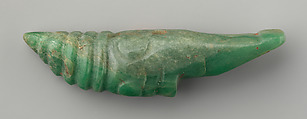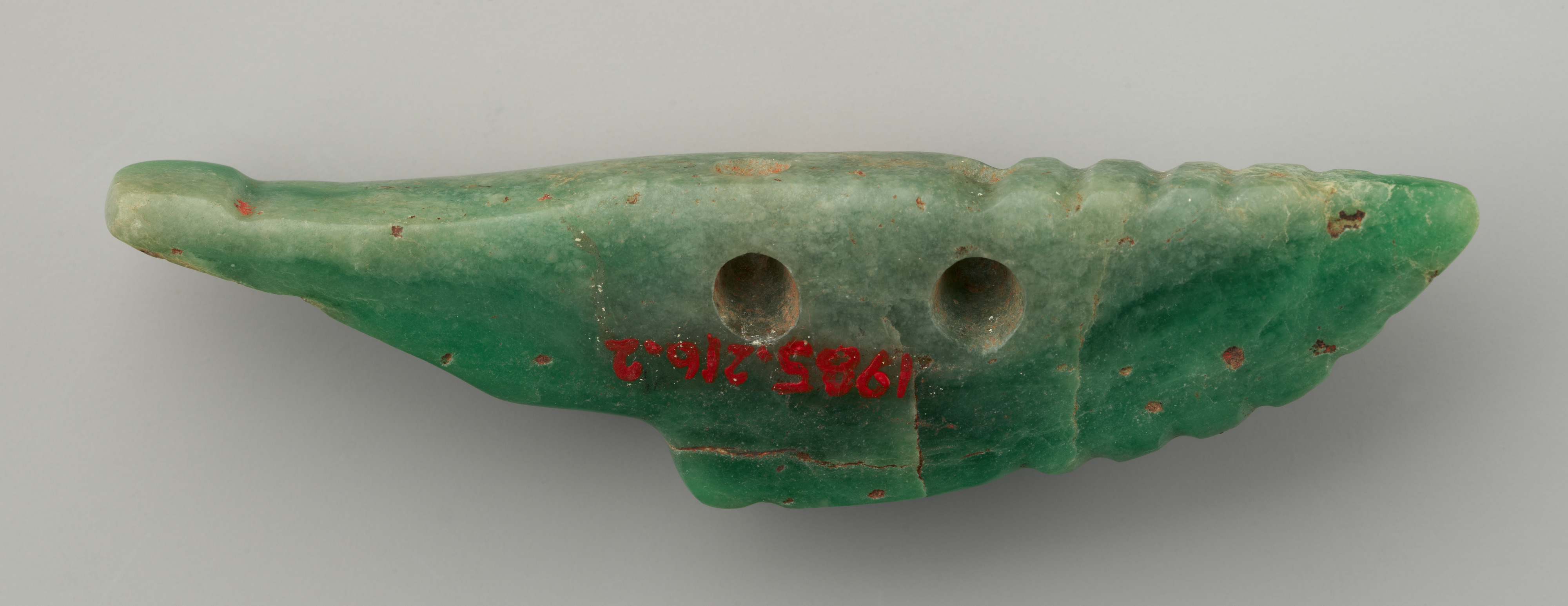Shell Ornament
Not on view
This ornament of blue-green jade is carved into the shape of a spiral-tipped snail shell. The natural model for this jade carving was likely a "tulip-" or "spindle snail," scientifically known as the Fasciolariidae family of shells, a widespread mollusk that inhabits temperate to tropical saltwater environments. Two large, L-shaped holes are drilled into the longer side of the ornament, indicating that it was originally suspended, likely as a pendant from a necklace.
In determining the shape of this shell pendant, the artist chased a vein of bright green jade within a lighter jade matrix. The upper, central portion of the shell is a mottled, light blue-green. This contrasts against a thick, curved lens of more vibrant, bright green that follows the contours of the shell’s lower half. The front face of the pendant is polished to a glossy, liquid shine. The back of the pendant, which would have rested against the wearer’s chest, is completely flat. Though smoothed and finished, it was left unpolished.
The word jade, when used in Mesoamerican contexts, refers specifically to jadeite. Although this mineral comes in a startling array of colors, the ancient Maya prized bright green and blue-green varieties most highly. All Mesoamerican jade comes from a single source, located in the Motagua River Valley of eastern highland Guatemala. Such a restricted point of access made jade a particularly rare and valuable material, an important element in elite trade networks and economic exchange systems in the ancient Maya world.
Jade approaches 7 on the Mohs scale of hardness (diamond has a hardness of 10), so it is extremely difficult to carve. In order to transform a raw jade boulder into a polished, finished form, specialists used a combination of percussion and abrasion techniques (such as pecking, grinding, sawing, incising, and drilling). This work was repetitive, time consuming, and required a highly specialized skillset. Creating a finished ornament like this from the rough boundaries of raw jade would have been enormously slow and difficult work, a fact that would have likely increased the value and preciousness of the final product.
Jade was considered the most precious of all materials in the ancient Maya world. The fact that jade endured, unchanged, for centuries, connected it to ideas of timelessness, permanency, and longevity. Its vibrant color was likened to other precious green things, including ripening crops and the iridescent tail feathers of the quetzal bird. In directional symbolism, the color green was associated with the cosmic center, a place described in inscriptions with the hieroglyph yax, meaning blue/green/unripe/new. The shape of this ornament, which replicates a saltwater shell, would have linked its wearer not just with the center of the world, but the primordial sea from which the earth was believed to have arisen in mythical time.
When polished, jade reaches a high, glossy shine, as though the surface has been dipped in water. It is almost always cool to the touch, but when held, quickly takes on the warmth of a human hand. This process led the ancient Maya to conceive of jade as a breathing, living, animate, and ensouled substance. To the ancient Maya, then, jade was not just beautiful, exotic, and expensive, but the incarnation of water, mist, floral aroma, and living breath. Jade was so closely linked to ideas of animating breath that a jade bead was frequently placed in the mouths of high-ranking dead upon their burial as a symbol of eternal life.
This pendant is what scholars call a skeuomorph, the representation of one material (shell) made in another (jade). The ancient Maya frequently played on ideas of materials and materiality, sculpting clay into the shapes of gourds, painting ceramic vessels to look like wood, or in this case, carving jade into the form of a shell. Shell often decomposes in the humid tropics, while jade retains its luster for millennia. This ornament, then, embodies all of the symbolism and connections of precious, perishable shell, but translates them into a permanent medium.
Like jade, shell was considered a valuable and exotic material. Although shell has a hard surface (resembling the hardness of a tooth), its thin profile makes it subject to breakage. It is thus difficult to carve, requiring its own suite of specialized artistic and technical training. The acquisition of certain shells was associated with great effort, even danger, whether diving into the ocean or into deep freshwater. Shells frequently traveled long distances across the Maya world before reaching their final destinations, making this an exotic, expensive, and precious material. Shells in both carved and un-carved formats were frequently placed in elite burials and other offerings. When carved, they took on a dazzling array of forms, comprising an important aspect of elite dress and ornamentation (see 1978.412.103 and 1979.206.951).
Shell came from the water and was thus closely connected to concepts of the primordial sea and the world’s mythical beginnings. It was also closely connected to ideas of breath, wind, and moisture. Chahk, the Maya storm god, for instance, wears a spondylus shell earflare (see 1978.412.206 and 1980.213), while other Mesoamerican wind gods, like Ehecatl, wear shell pendants and ear ornaments. Modern day beach-goers often claim they can hear the sounds of the ocean when they press a shell to their ears. Similarly, the ancient Maya considered shells embodiments of the sounds, aromas, and moisture of the ocean. This explains why the misty tips of waves are so often depicted in Precolumbian art as stacked or spiral-shaped seashells. Ancient Maya dance costumes were often fringed with shell "tinklers," which would have rattled according to the dancer’s movement, while conch shell trumpets were an important aspect of ceremonial practices, hunting rites, and warfare. Shell was thus associated with all kinds of noise, from rattles to trumpet blasts, to ocean waves, to the sounds of an oncoming rainstorm.
Traces of a bright red pigment, likely cinnabar, can be seen in some of the crevices of this ornament. As cinnabar was frequently used to paint the bodies of deceased royalty and their belongings, it is very likely that this jewel was found in a tomb context. Red cinnabar was closely linked to blood, while green jade was associated with living breath, new growth, and life. When subjected to intense heat and pressure, cinnabar turns into silver mercury, a seemingly magical metamorphosis. The combination (and juxtaposition) of blood red cinnabar with bright green jade in the context of a tomb was thus highly symbolic, connected to ideas of eternal life and (echoing the transformation of cinnabar into seemingly supernatural mercury) rebirth into divine realms from the earthly world.
This jade pendant, then, embraces a multiplicity of meanings. It was not just a sign of wealth, prestige, and special access to exotic goods, but communicated important ideas about living breath, agricultural success, water, the center of the world, and ancestral origins. Solid, unchanging jade gives weight to momentary and ephemeral concepts, creating an exquisite tension and intersection between materials and meanings.
Lucia R. Henderson, Pamela and Sylvan C. Coleman Fellow, 2015
Cited Sources and Further Reading
Finamore, Daniel, and Stephen D. Houston, eds. Fiery Pool: The Maya and the Mythic Sea. Salem and New Haven: Peabody Essex Museum and Yale University Press, 2010.
Houston, Stephen. The Life Within: Classic Maya and the Matter of Permanence. New Haven and London: Yale University Press, 2014. See especially pp.31-49, 56-73.
Houston, Stephen D., David Stuart, and Karl A. Taube. The Memory of Bones: Body, Being, and Experience among the Classic Maya. Austin: University of Texas Press, 2006. See especially Chapter 4.
Houston, Stephen D., and Karl A. Taube. "An Archaeology of the Senses: Perception and Cultural Expression in Ancient Mesoamerica." Cambridge Archaeological Journal 10, no. 2 (2000): 261-94.
Houston, Stephen D., and Karl A. Taube. "The Fiery Pool: Fluid Concepts of Water and Sea among the Classic Maya." In Ecology, Power and Religion in Maya Landscapes, edited by Christian Isendahl and Bodil Liljefors Persson, pp. 11-37. Markt Schwaben: Verlag Anton Saurwein, 2011. See especially p.16.
Pillsbury, Joanne, Miriam Doutriaux, Reiko Ishihara-Brito, and Alexandre Tokovinine, eds. Ancient Maya Art at Dumbarton Oaks, Pre-Columbian Art at Dumbarton Oaks, No. 4. Washington, D.C.: Dumbarton Oaks Research Library and Collection, 2012. See especially pp.154-271, 440-463. Also see Taube and Ishihara-Brito, below, and Velázquez Castro, below.
Stuart, David. "Jade and Chocolate: Bundles of Wealth in Classic Maya Economics and Ritual." In Sacred Bundles: Ritual Acts of Wrapping and Binding in Mesoamerica, edited by Julia Guernsey and F. Kent Reilly, pp. 127-44. Barnardsville: Boundary End Archaeological Research Center, 2006.
Taube, Karl A. "The Breath of Life: The Symbolism of Wind in Mesoamerica and the American Southwest." In The Road to Aztlan: Art from a Mythic Homeland, edited by Virginia M. Fields, pp. 102-23. Los Angeles: Los Angeles County Museum of Art, 2001.
Taube, Karl A. "The Jade Hearth: Centrality, Rulership, and the Classic Maya Temple." In Function and Meaning in Classic Maya Architecture, edited by Stephen Houston, pp. 427-79. Washington, D.C.: Dumbarton oaks Research Library and Collection, 1998.
Taube, Karl A. "The Symbolism of Jade in Classic Maya Religion." Ancient Mesoamerica 16 (2005): 23-50.
Taube, Karl A., and Reiko Ishihara-Brito. "From Stone to Jewel: Jade in Ancient Maya Religion and Rulership." In Ancient Maya Art at Dumbarton Oaks, edited by Joanne Pillsbury, Miriam Doutriaux, Reiko Ishihara-Brito and Alexandre Tokovinine. Pre-Columbian Art at Dumbarton Oaks, No. 4, pp. 134-53. Washington, D.C.: Dumbarton Oaks Research Library and Collection, 2012.
Velázquez Castro, Adrián. "Pre-Columbian Maya Shell Objects: An Analysis of Manufacturing Techniques." In Ancient Maya Art at Dumbarton Oaks, edited by Joanne Pillsbury, Miriam Doutriaux, Reiko Ishihara-Brito and Alexandre Tokovinine. Pre-Columbian Art at Dumbarton Oaks, No. 4, pp. 432-39. Washington, D.C.: Dumbarton Oaks Research Library and Collection, 2012.
Zender, Marc. "The Music of Shells." In Fiery Pool: The Maya and the Mythic Sea, edited by Daniel Finamore and Stephen D. Houston, pp. 83-85. Salem and New Haven: Peabody Essex Museum and Yale University Press, 2010.
Due to rights restrictions, this image cannot be enlarged, viewed at full screen, or downloaded.
This artwork is meant to be viewed from right to left. Scroll left to view more.



